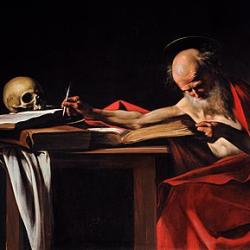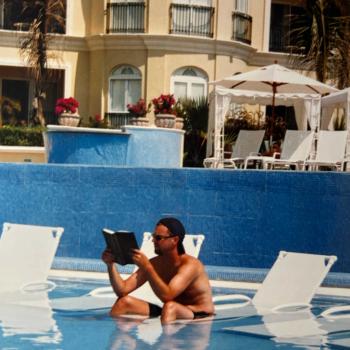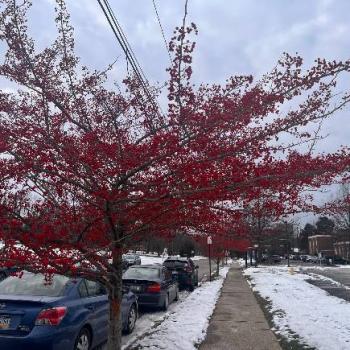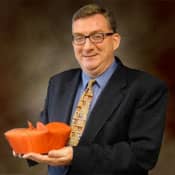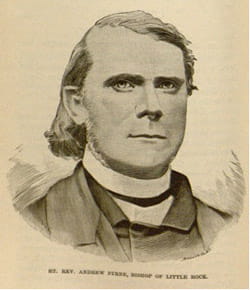 |
| Bishop Andrew Byrne: Quixotic in Arkansas |
For many years, Father Eugene Weibel rode his horse Rocinante (named for Don Quixote's horse) across the State of Arkansas ministering to a scattered Catholic population. One day in the year 1881, he found himself near the town of Opposition. Seeing a farmer, he asked if there were "any Catholics hereabouts." "No," came the answer matter-of-factly. "We do not grow such things here."
At times, planting the seeds of Catholicism in Arkansas soil may well have seemed a quixotic task. For most of the 1800's, Catholic numbers barely exceeded one percent of the total population. In 1843, the Diocese of Little Rock, covering the entire state, was erected, and it fell to the first Bishop to create a framework for Catholic where none existed.
We don't know the exact day Andrew Byrne was born, but it likely occurred on November 30th, the Feast of St. Andrew, in 1802. Raised in Navan, County Meath, he began priestly studies early. When Bishop John England of Charleston, South Carolina, visited his seminary looking for future priests, Andrew volunteered. In 1827, he was ordained for the Diocese of Charleston, then covering Georgia and the Carolinas.
He proved a capable administrator, and Bishop England named him Vicar General (a sort of diocesan chief operating officer). In 1836, he left Charleston for New York. After serving as pastor of two Manhattan parishes, he founded a third, which he named St. Andrew. One historian notes that he was "favorably known as a preacher, being gifted with a rich and powerful orotund voice, an imposing presence and a flow of language that rarely failed to move an audience."
When Pope Gregory XVI erected the Diocese of Little Rock, Father Byrne was named Bishop. On March 10, 1844, at Old St. Patrick's Cathedral on Mott Street in Manhattan, he was consecrated a bishop. It was a unique event in the cathedral's history, for along with him were William Quarter, first Bishop of Chicago, and John McCloskey, New York's first Auxiliary Bishop (and future Cardinal).
There was no episcopal residence; he stayed at a boarding house in Little Rock until one was built. Although he had worked in the South before, nothing prepared him for Arkansas, which was then seen as "a place of violence, lawlessness and poverty" having "few of the amenities of civilization." In 1846, at a gathering of the American Bishops, he asked to have the diocese dissolved. He hoped to be transferred East, but it never happened. Byrne wrote a friend:
I can assure you that within the while diocese of Little Rock there exist no means to erect a single altar. The Catholic population does not exceed seven hundred souls, and they are scattered in every county in state.
Still, his was a "naturally buoyant nature." In 1846, having purchased property in Little Rock, he consecrated a diocesan cathedral, which he named for St. Andrew. (The diocesan coat of arms is also emblazoned with a St. Andrew cross.) Three years later, he opened Arkansas' first Catholic college, St. Andrew's, which closed on the eve of the Civil War.
In 1851, Irish Sisters of Mercy under Mother Teresa Farrell founded what became known as Mount St. Mary's Academy in Little Rock, now the state's oldest educational institution. They founded two more schools over the next decade. At a time when no public school system yet existed, Protestant students often outnumbered Catholic ones. But anti-Catholicism was still strong, and the Sisters promised not to let any students convert without their parents' permission.
Still, progress was slow. During the years 1850-1860, the Catholic population rose from .98 to one percent. At the same time, Methodist churches tripled and Baptist churches more than doubled. In a thoroughly Protestant culture, Catholics were an oddity. When one priest preached to a crowd in a cassock, one observer said: "Young man, you preach with might and glory, but you should put your shirt into your trousers." Another priest wrote:
When entering a country boarding house in Arkansas, the first thing a Priest should do is take off his hat. This simple act of politeness, while highly gratifying to the Catholics, affords a pleasing surprise to the unbelieving country "folk," who heretofore imagined every Priest had two horns on his forehead.
